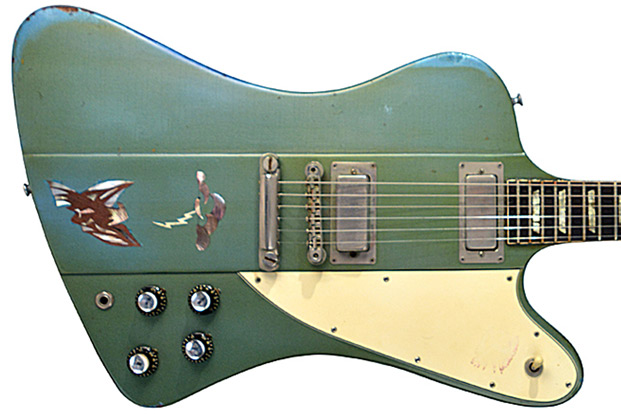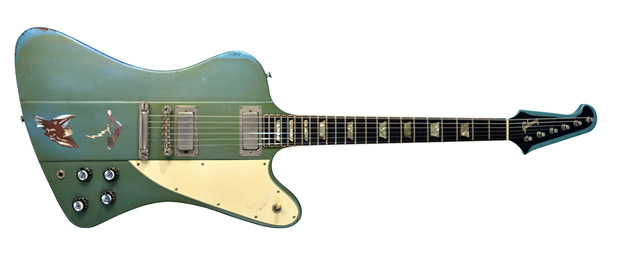Johnny Winter’s Gibson Firebirds and Lazer Guitars Head to the Auction Block

Several Johnny Winter guitars will be among the more than 400 rarities from the guitarist’s collection that head to Guernsey’s auction block September 30 and October 1.
- Gibson Firebirds, Erlewine Lazers and even Winter’s very first and last guitars—a ukulele and a Dean B. Zelinsky prototype, respectively—will be included in the auction. Other personal items include notebooks of handwritten music, a pair of purple velvet bell-bottom pants with a matching button-down jacket, a rattlesnake hat, a pink dragon kimono and, oddly, beard clippings.
- The auction is a significant trove of Winter’s personal effects, offering a rare opportunity for fans to see and purchase relics from the career of the celebrated electric blues guitarist. But it is, of course, the guitars that will, in all likelihood, be the stars of the event.
Winter came to the forefront of the electric blues scene in 1969 with the release of his major-label debut, Johnny Winter. He performed the album’s stunning guitar work using a 1966 Fender Mustang, but the following year he adopted what would become his main guitar for many years: a 1963 Gibson Firebird V that he purchased in St. Louis.
“I was initially attracted to the Firebird because I liked the way it looked,” Winter told Guitar Aficionado in early 2014. “When I played it, I discovered I liked the way it sounded too. The Firebird is the best of all worlds. It feels like a Gibson, but it sounds closer to a Fender than most other Gibsons. I was never a big fan of humbucking pickups, but the mini humbuckers on the Firebird have more bite and treble.”
In the mid Eighties, Winter began playing Lazer guitars designed by Mark Erlewine after the luthier presented him with a black model, fitted with a single humbucking pickup, during a 1984 show in Texas. Winter would eventually own six of the unusual-looking small-bodied, headless guitars.
“When I first bought one, I thought I was just going to use it as a travel guitar,” Winter told Guitar Aficionado. “But the first day I plugged it in, it sounded so good that I wanted to use it for a gig that night.”
Winter’s career was marked by ups and downs attributed to drug use and, later, health issues and methadone addiction. He was enjoying a career resurgence when he died in a hotel room near Zurich, Switzerland on July 16, 2014, two days after completing a European tour.
Below we’ve featured several of Winter’s personal guitars included the auction, along with their catalog notes.
All the latest guitar news, interviews, lessons, reviews, deals and more, direct to your inbox!
The auction opens 6 p.m. September 30 at Gibson Brands New York Showroom, 421 W. 54th St., New York City. It continues noon til complettion October 1. Public previews take place 2 to 6 p.m. September 28, noon to 7 pm. September 29, noon to 6 p.m. September 30 and 10 a.m. to noon October 1.
For more information about the Johnny Winter auction, visit Guernseys.com.

Black Lazer Guitar
One of Johnny Winter’s famous Lazer guitars. Johnny can be seen playing this black model in a recorded performance from the 1984 Montreux Jazz Festival in Montreux, Switzerland, documented in the video below. Some oxidation on metal. Bears LAZER logo on body. Slight paint chipping on left side of back and right edge of back. Total length 31 inches.

Circa 1965 Gibson Firebird V in Inverness Green
Johnny Winter’s name is virtually synonymous with Gibson Firebirds. His rare “Inverness Green” Firebird, with custom pearl inlay, is simply breathtaking. Winter played it live for many years at some of his largest shows. This guitar is prominently featured in Winter’s worldwide Sony film release, Down n’ Dirty, The Johnny Winter Story, out March 5, 2016.
Serial No. 255115. Vibrato tailpiece (which was standard with Firebird V) has been removed by Johnny, as he preferred the sound of the guitar without them. Features iridescent inlay of an eagle and cloud with an emerging lightning bolt on front of body. Feature iridescent notches along fretboard. Faded “Firebird” logo on front of body. Ombre [blending] effect along backside from top of headstock to bottom of strap button, fades from turquoise to a bright green. Back of headstock has a 1-inch crack and entirety of back shows some slight paint chipping.

Terraplane “Johnny” Guitar
This truly one-of-a-kind guitar was made by luthier Mark Simon (founder of Terraplane Resonator Guitars) for Johnny Winter; presented to Johnny at B.B. King Blues Club & Grill in New York City in 2008. Steel guitar, Johnny cutout with red velvet inlay on body of guitar. Terraplane Resonator guitars. Pearloid headstock overlay.

Johnny Winter’s First Guitar
A Harmony ukulele believed to be Johnny Winter’s first guitar, given to him by his great-grandfather, whom he affectionately called Ole Pa, and for whom he named his music corporation. In a photo being presented in this auction, Johnny is pictured holding this instrument as a child with his brother Edgar. He appears to have scratched “Johnny Winter” on the bottom of the body, though it is now faded and barely legible. The ukulele features two finishes of wood and a tassel looped around the neck of the guitar. Total length 30 inches.

Johnny Winter Prototype Guitar
Beaumont Special. By Dean B. Zelinsky. No. 1 Prototype. According to bandmate Paul Nelson, this beautiful, heavily engraved instrument is the last guitar Johnny played before he died, and he can be seen playing it in a video recording of his 70th Birthday Bash concert at B.B. King Club in NYC, documented on in the video below, which shows Winter performing with Popa Chubby on February 23, 2014.

1963 Gibson Firebird V
Johnny Winter’s 1963 Sunburst Firebird is one of the most recognizable guitars in the blues and rock and roll. It was played by Johnny on the Muddy Waters Grammy award-winning albums, which he also produced: Hard Again (1977), Ready (1978), and Mississippi Waters Live, (1979). It was used for most of Johnny Winter’s own recordings and many of his slide-guitar tunes, right up until his death. Winter played it on the David Letterman show in 2012.
Sunburst finish. Shows many signs of wear and use, including: slightly faded Firebird logo on pick guard, metal shows signs of oxidization, missing tailpiece and paint chipping along both sides of body. 3/4-inch crack at the bottom of front of body.

1964 Gibson Firebird V
There are some instruments that become as iconic as the artists that play them, and such is the case for Johnny Winter’s Polaris White Firebird, considered to be the “Holy Grail” of all rock guitars. Features iridescent (mother of pearl) notches along fretboard. This guitar is pictured on the cover of Winter’s historic Captured Live! album and countless other photographs. This is truly a wonderful instrument, a one-of-a-kind piece of rock and roll history. Tailpiece was removed deliberately by Johnny Winter per his preference.
Serial No. 242133. Tailpiece removed by Johnny, as he preferred the sound of the guitar without it. Many signs of frequent use, including: Faded, worn “Firebird” logo on pick guard. Gibson logo on headstock has worn off. Some signs discoloration, and chipping paint. Winter can be seen playing this Firebird in a video recording of a 1987 performance in Sweden, shown below, as well as countless other performances.

White Erlewine Lazer
Johnny once described his main ax, the Lazer, as follows: “It’s really the closest thing I’ve found to sounding like a Strat and feeling like a Gibson. I like the sound of a Strat, but just can’t play one. It just doesn’t feel right to me. If I pull the strings, I don’t get as much out of it as I put into it. I can put the same effort into a Gibson and get back twice as much. With the Lazer I get both.”
Weighing in under six pounds and only 31 inches long, the Lazer features a full-sized, 25.5-inch scale, 24-fret neck, a humbucker and a single-coil pickup, master volume and master tone controls and three-position pickup selector switch. The secret to the Lazer’s compact size is an ingenious string-clamp at the end of the neck and the multi-purpose Wineomatic bridge and tuning system, both adorned with heavy-duty, industrial-strength chrome plating. Unlike other headless beasts that require double ball-end strings, the clamp lets you use ordinary guitar strings. The Wineomatic bridge features six large knurled knobs fanned out at the rear of the guitar that make it easy to tune the Lazer precisely.
Christopher Scapelliti is editor-in-chief of Guitar Player magazine, the world’s longest-running guitar magazine, founded in 1967. In his extensive career, he has authored in-depth interviews with such guitarists as Pete Townshend, Slash, Billy Corgan, Jack White, Elvis Costello and Todd Rundgren, and audio professionals including Beatles engineers Geoff Emerick and Ken Scott. He is the co-author of Guitar Aficionado: The Collections: The Most Famous, Rare, and Valuable Guitars in the World, a founding editor of Guitar Aficionado magazine, and a former editor with Guitar World, Guitar for the Practicing Musician and Maximum Guitar. Apart from guitars, he maintains a collection of more than 30 vintage analog synthesizers.


